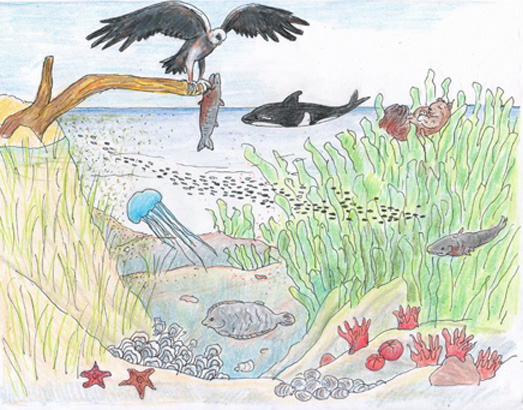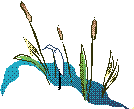Coastal Aquatic Zones
Background reading - Global Lab |

Joan Bredin-Price
"The coastal zone is the site of important physicochemical reactions between saltwater and freshwater flows; it is the zone of highest biological productivity, supporting marine life ranging from plankton to fish, turtles and whales."
J.W. Maurits la Riviere. "Threats to the World's Water", Scientific American, September 1989, p. 8
|
Types of Coastal Systems
Coastal systems include:
Estuaries
Salt marshes
Beaches (sandy, rocky, cobblestone)
Barrier islands |
Key Characteristics of Coastal Systems
Coastal systems are tidal. The rotation of the Earth, the centripetal force caused by the revolution of the Earth and Moon, and the gravitational pull of the Moon and Sun effect the comparative ocean water level, at different locations, causing tides.
Since coastal systems are tidal, they experience constant changes in temperature, salinity, food availability, oxygen availability, water level and wave strength.
Plants and animals in the coastal systems are adapted to the daily changes caused by the tides.
In general, coastal systems have higher salinity than open oceans and seas, because runoff over coastal rock materials provides salt to the water. This is not true near the mouths of rivers. |
Estuaries
 Estuaries are one type of coastal system. They occur where river mouths have been flooded by sea water. Tides deposit mud and silt onto intertidal flats. The plants and animals that live within these flat are used to an extraordinary mix of conditions, including both salt- and freshwater and daily fluctuations in temperature. Plants help stabilize the soil, and eventually these estuaries become stable wetlands. Estuaries are one type of coastal system. They occur where river mouths have been flooded by sea water. Tides deposit mud and silt onto intertidal flats. The plants and animals that live within these flat are used to an extraordinary mix of conditions, including both salt- and freshwater and daily fluctuations in temperature. Plants help stabilize the soil, and eventually these estuaries become stable wetlands.
Estuaries (and most coastal wetlands):
- regulate flow and store water during heavy rainfall
- filter and dilute pollutants
- provide a base for aquaculture, which produces some 10 percent of the world's fish harvest.
- provide a nursery for fish and other species, especially the coastal mangrove forests, which also produce timber.
|
Beaches
 Beaches are another kind of coastal system. Experts are able to look at beach sand and stones and tell much about the kind of shoreline that produced them. Beaches are another kind of coastal system. Experts are able to look at beach sand and stones and tell much about the kind of shoreline that produced them.
Waves tend to sort rocks, stones and sand. This, beaches can be rock, cobblestone or sandy. Long, sandy beaches exist where water has had enough time and protection to erode rock into sand.
Beaches can also differ greatly in terms of color. The color of sand depends on the color of the rock from which it was formed.
Generally:
White (yellow, pink) sand beaches are formed from quartz and feldspar, or coral.
Black sand beaches are formed from eroded volcanic sources, magnetite (iron) or hornblende.
Pink and purple sand beaches are formed from garnet.
|
 Coastal Adaptations Coastal Adaptations
Coastal systems teem with life of various sizes: unicellular plants and animals, tiny mites and worms, marine crustaceans and larger animals. This life must adapt to the fluctuations caused by tides. These include daily changes in water coverage, temperature, salinity levels, food availability, oxygen availability, and wave strength.
The adaptations of plants and animals to these conditions are varied and ingenious. Consider the following examples:
- Starfish, mussels, seaweed wracks and barnacles can all sustain different exposure to air and submersion in water.
- The entrance to a periwinkle's shell can be sealed to prevent water intake when the periwinkle is covered by the tide.
- The mole crab burrows in the sand, facing the incoming waves. After the wave's action is spent, it sends it feathered antennae up into the waves to catch food.
 Crab with kelp camouflage Crab with kelp camouflage |
Environmental Challenges
There has always been an uneasy relationship between human beings and the coasts. Shorelines are continually moving, being shaped by ocean waves, but humans like their buildings to stay in one place.
To keep coastal beach waters from washing away, humans have tried various solutions:
Breakwaters
Cost: the beach further down the boast receives the sand.
Sea walls to retain sand
Cost: waves break from underneath the sea wall and hasten erosion.
Pumping sand from further out at sea back onto the beaches.
Cost: money; beaches down the coast lose sand.
Human living inland affects coastal systems as well. All water runoff eventually reaches the coastal areas. Sewage discharge causes eutrophication of coastal waters. Since coastal waters are nurseries for fish and crustaceans, this runoff can have serious effects. Specifically, fossil fuels such as oil and gas runoff can cause cancerous lesions in fish. Detergents can cause too much algae growth.
Last three pictures, used with permission from :
San Francisco Marine Science Center
http://sfbayvirtualvoyage.com/virtualbay/
See their Marshes and Mudflats Education Guide on their resources page:
http://www.sfbaymsi.org/resources.html
Back to Describing Your Water Site
Back to Water Index |

 Estuaries are one type of coastal system. They occur where river mouths have been flooded by sea water. Tides deposit mud and silt onto intertidal flats. The plants and animals that live within these flat are used to an extraordinary mix of conditions, including both salt- and freshwater and daily fluctuations in temperature. Plants help stabilize the soil, and eventually these estuaries become stable wetlands.
Estuaries are one type of coastal system. They occur where river mouths have been flooded by sea water. Tides deposit mud and silt onto intertidal flats. The plants and animals that live within these flat are used to an extraordinary mix of conditions, including both salt- and freshwater and daily fluctuations in temperature. Plants help stabilize the soil, and eventually these estuaries become stable wetlands. Beaches are another kind of coastal system. Experts are able to look at beach sand and stones and tell much about the kind of shoreline that produced them.
Beaches are another kind of coastal system. Experts are able to look at beach sand and stones and tell much about the kind of shoreline that produced them. Coastal Adaptations
Coastal Adaptations Crab with kelp camouflage
Crab with kelp camouflage